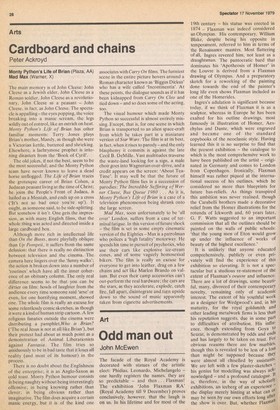Art
Odd man out
John McEwen
The facade of the Royal Academy is decorated with statues of the artistic elect: Phidias, Leonardo, Michelangelo one hardly registers the names, they are so predictable and then . Flaxman! The exhibition 'John Flaxman RA' (Royal Academy till 9 December) proves conclusively, however, that the laugh is on us. In his lifetime and for most of the 19th century his statue was erected in 1874 Flaxman was indeed considered an Olympian. His contemporary, William Blake, despite being his opposite in temperament, referred to him in terms of the Renaissance masters. Most flattering of all, Ingres revered him, not least as a draughtsman. The pantocratic bard that dominates his 'Apotheosis of Homer' in the Louvre is derived from a Flaxman drawing of Olympus. And a preparatory sketch for a reworking of the painting done towards the end of the painter's long life even shows Flaxman included as one of the Homerides.
Ingres's adulation is significant because today, if we think of Flaxman it is as a sculptor, whereas in Europe he has been exalted for his outline drawings, most famously in illustration of Homer, Aeschylus and Dante, which were engraved and became one of the standard copybooks of the neoclassic style. Having learned this it is no surprise to find that the present exhibition the catalogue to which is the most comprehensive work to have been published on the artist originated in Germany and comes to London from Copenhagen. Ironically, Flaxman himself was rather piqued at the international success of his outlines, which he considered no more than blueprints for future bas-reliefs. As things transpired this ambition was never realised, though the Carabelli brothers made a decorative relief from the Homer illustrations for the rotunda of Ickworth and, 60 years later, G. F. Watts suggested to an important commission that all the outlines should be painted on the walls of public schools: 'that the young men of Eton would grow up under the influence of works of beauty of the highest excellence.'
It is unlikely that anyone educated comprehensively, publicly or even privately will find the experience of this exhibition so elevating. It is not a spectacular but a studious re-statement of the extent of Flaxman's oeuvre and influence. There are a lot of drawings, some beautiful, many, divorced of their contemporary novelty, remaining only of academic interest. The extent of his youthful work as a designer for Wedgwood's and, in his maturity, for the royal goldsmith and other leading metalwork firms is less than his reputation suggests, due in some part to difficulties of attribution. His inflw ence, though extending from Goya to Seurat, is demonstrated by odds and ends and has largely to be taken on trust. For obvious reasons there are few marbles, though this is revealed to be less of a loss than might be supposed because theY were almost all chiselled by assistants. We are left with a few plaster-sketches his genius for modelling was always ack" nowledged and a profound catalogue. It is, therefore, in the way of scholarlY exhibitions, an iceberg of an experience the display merely hinting at what can (;It may be seen by our own efforts long after the show is over. But, whether Flagoan did the chiselling or not, it does irresistibly succeed in urging us to review the beauty of his funereary monuments in Chichester Cathedral, Micheldever Church and elsewhere; and, on the basis of their pious simplicity of feeling and poetic elegance of line, challenges us to name a better English sculptor, not only of his time but even since the Middle Ages. Certainly it will stifle the guffaws in the forecourt of Burlington House.







































 Previous page
Previous page